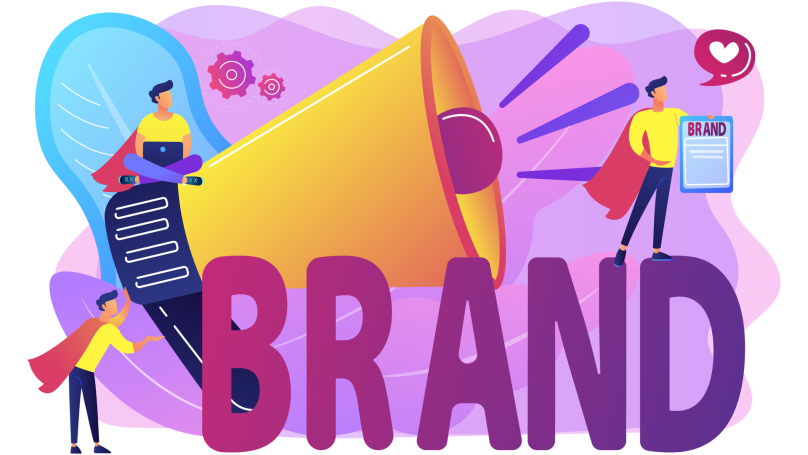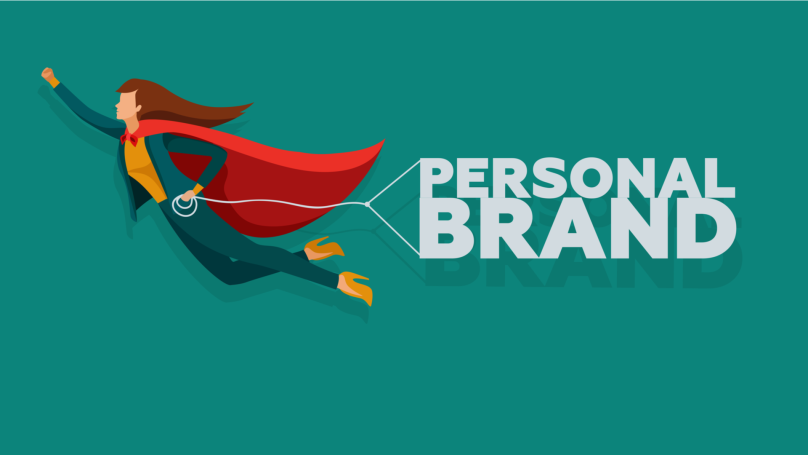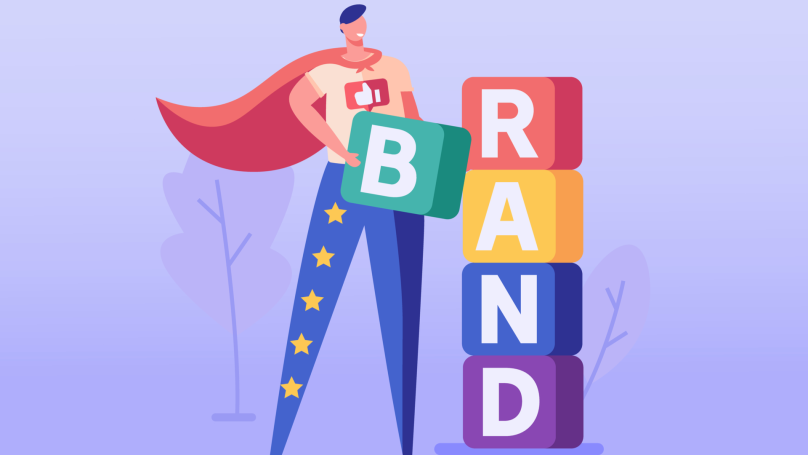Branding
What is branding?

Branding creates and promotes a company's positive image to increase customer loyalty and brand recognition. Branding involves many processes and concepts: creating a company image, developing a mission and values to position a firm in the market, and selecting channels to communicate with customers. Branding also often uses the unconscious dimension of the psyche by appealing to a person's associations, habits and triggers.
In layman's terms, branding is brand management. A brand, in turn, is the corporate identity and brand of a company, the embodiment of its name and reputation. Thus, branding allows the company to create its unique style, which, in turn, increases the value of the product and helps to build a long-term and trusting relationship with the audience. Today, large retail is virtually impossible without branding.
Functions of branding
Branding includes the following set of tasks:
- It creates the necessary attractive image of the company itself or its specific products.
- It strengthens the status and position of the company in the market.
- It argues the value of products, creates associative meaning and enhances their importance in consumers' values.
- It builds communication between the company and its audience.
- It selects and optimises marketing channels and promotional strategies.
- It allows competitive advantages to be highlighted and properly exploited.
- It separates itself from competitors and builds brand identity.
Thus, all branding functions and tasks aim to strengthen the brand's market position and increase the effectiveness of its promotional activities or new events such as product launches.
Stages of branding

Branding development involves the following stages:
- Market analysis. It includes competitor and target audience research, defining dominant market trends, the competitive environment, and the key needs of potential customers.
- An audit of the current state of the brand. If a company has been in the market for some time, you need to collect all available information about its reputation, recognition, positioning, etc. That will help identify which branding archetypes to use in your case.
- Formulating a brand idea and values. You need to create the core of your future image, define your company values, and the products your brand should communicate to customers. It would be best to build on your company's culture and competitive advantage. Suppose you are a flexible internet platform with the latest and cutting-edge courses, for example. In that case, your core value may emphasise practice for the real-life benefit and freedom to act in self-education.
- Creating identifying brand elements. Once you have created the vision of brand values and audience needs, you can bring one together with the other. A set of identifying elements includes company name, slogan, brand legend/history, symbols, logo and fonts, which will create a unified brand identity and characterise the brand.
- Creation of a brand book and guidebook. To create a holistic picture of your brand, you need to combine the visual and verbal branding elements created in the previous stages. You do this by developing a brand book (a formal document that guides the company's culture, values and style) and a style guide (a guide to using the brand's style). They systematise all the brand attribute options for their use and combination and describe the methods and channels of communication with clients.
- Creating a long-term promotional strategy based on the assembled brand book and guidelines. Here, you are at the most important and sensitive stage, which includes building the brand development for one, three or five years ahead, depending on its scale, niche prospects and company goals.
- Analytics and implementation. Before implementing the branding, the project details need to be reviewed and analysed again, correlating with the actual market situation and testing the hypotheses. Only then can the implementation begin in earnest.
The branding agency can carry out all these stages independently and propose to order turnkey branding. The cost of branding and the price of associated services vary depending on the size of the business, its goals and niche.
Branding tools

Use the following tools for brand building:
- Creating a brand architecture. That includes brand structure, brand portfolio, roles and graphical representation.
- Creating brand identity elements (logo, slogan, style, etc.) based on the set of qualities that the audience should further associate with the brand.
- Creating communication programmes. That includes creating advertisements posters, shooting promo videos, sponsorship programmes, campaigns and optimising the website for its promotion to the top.
Branding strategies
Four main instruments are generally accepted to help in creating a unique company brand that will be popular:
- Co-brand. A strategy for combining multiple brands into one programme with common goals, such as increasing sales, profits and consumer demand. For example, a bank and its partners' programme provides better deals. The question may arise: what is co-branding? The answer is it is the same as a co-brand.
- Multi-brand. The development of several brands simultaneously under one product line with a common goal and identity. It promotes each product individually, but the individual product does not lose its association with the company's main brand.
- Mono-brand. You build your products under a single brand to minimise risk and resources, but with maximum efficiency to ensure that both the brand and products are of the highest quality.
- Sub-brand. One brand is always the main brand, and the others act as additional brands and help attract the audience. This branding strategy is similar to a co-brand but differs in the nature of the relationship between the complementary companies (in a co-brand, they are partners, and in a sub-brand, they are subordinates).
Types of branding

There are the following types of branding:
Corporate branding
Company branding or corporate branding is creating a company's image to increase the trust of customers, partners and the company's employees. This type of branding is the development of culture, ideology, values, mission and brand within the company. And this type of branding has an impact not only on the target audience but also the employees themselves: they feel that they are an important part of the company, that they bring value and are helpful to the business processes. The human resources department also follows corporate branding by attracting relevant, experienced, and interesting professionals to the company in particular.
Corporate branding may go beyond a specific brand or name and include standard components like a logo and image and specific internal policies. For example, free training or treatment for employees, special office arrangements, etc., could be part of the corporate brand. Such means that affect a company's reputation and allow people to interact with the company also build its brand and influence the perception of the company.
Product branding
Product branding is forming a recognisable image for a specific product, service or product line. It includes most of the corporate branding elements, i.e. slogan, design, colours, etc. Product branding aims to express the identity of a product, enhance its value and popularity in the market, show the features, and figuratively demonstrate its benefits to a potential customer.
Personal branding
Personal branding is the promotion of a particular person instead of a company, usually a well-known media personality or a professional who wants to monetise their knowledge and experience. This type of branding has become particularly relevant during the emergence of social media and expert bloggers.
Personal branding creates a recognisable and appealing image of a person to the target audience considering their skills, personal qualities, style and communicating ideas. The primary objective of personal branding is to make a person popular in a narrow professional circle. It is also here to build a community around them and gradually introduce them to related and larger arenas. The most important thing in this is to develop a strong and positive reputation. A prime example of good self-branding is Steve Jobs or Mark Zuckerberg.
Territorial branding
Territorial branding, or territory branding, is the brand of a country, region or specific territory, the promotion of which focuses on the site's cultural, political, economic or geographical attributes. In simple terms, it is the creation of an image of a particular place in the eyes of the public (both local and global). For example, city branding involves increasing the popularity of the city itself. Specifically, territorial branding helps to:
- attract investment to a region, contributing to its economic development (e.g. by attracting tourists or industry sponsors, other facilities);
- increase the influence of a region in geopolitics;
- establish partnerships both with international companies and different geographical locations.
National branding
National branding has much in common with territorial branding. It aims to measure, build and manage the reputation of countries through the application of marketing strategies and concepts at a global level. Usually, you do it to strengthen the global reputation, establish international relations, and launch joint projects with other countries.
But unlike territorial branding, national branding is not limited to geography. For example, it may also involve promoting the nation itself, its culture and values, or highlighting specific national products and technology to increase exports.
Political branding
Political branding is essentially the campaigning of candidates. It involves the creation of slogans, symbols, posters and promotional videos and the formation and promotion of the party. Political branding allows you to quickly and accurately communicate a candidate's values, goals and ideas to the public. Also, its unique feature is the short duration of campaigns, as elections are strictly time-limited. That is why political branding has to be fast and intensive. Every political campaign exemplifies it in history, such as the campaigns of Donald Trump or Joe Biden.
Co-branding
Co-branding is a form of collaboration between two or more brands, a joint project in which the brands retain their identity but create something new and outside their usual niche. In this way, they gain integrated access to new partner audiences and benefits, thereby increasing their visibility. As a rule, these collaborations are also short-lived, lasting from a few weeks to a few months. Longer branding can blur the companies' identity and lead to "splicing", making it ineffective. An example of co-branding is the Coca-Cola and OPI project, where Coca-Cola introduced its range of bright nail lacquers.
Examples of branding

Here are some more striking examples of branding in marketing:
- Elo Soap is a renowned Greek soap company that produces Greek soaps that contain olive oil. Corporate branding expert Mike Corolos developed an original design concept that visually highlighted the soap's Greek origins with appropriate colours and ornamentation and set Elo apart from the competition with contemporary-style illustrations of Greek gods.
- Pandora is the jewellery brand that emphasised the uniqueness of its jewellery, even though all its pieces get mass-produced. Its reputation as a "unique gift that will keep your memories alive" is supported by the idea of creating each bracelet independently. Resultingly, customers can combine different charms without changing the base - the bracelet itself - thus creating a unique designer piece of jewellery. It is a great application of branding in the fashion industry.
- Lego. The company producing children's construction materials took the market by its values - to inspire children, teach them to cooperate and solve problems creatively. It has been able to implement these values through special sets of the constructor to create and play out specific scenes - e.g., extinguishing a house, renovation, etc). Another powerful branding tool for Lego was the creation of its own content - producing films, games, and shooting popular videos for YouTube.
Books about branding
If you want to take branding training, master it from scratch, or add to your existing knowledge, start with the following books:
- Tom Peters; "The Brand You 50: Or: Fifty Ways to Transform Yourself from an "Employee" into a Brand That Shouts Distinction, Commitment, and Passion!"
Tom Peters heads the Tom Peters Company, an international consultancy. He has compiled all the methods and models for improving your performance in this book. Peters developed these methods using a lifetime of his own experience. Additionally, the book contains more than 50 tips on how to build a successful personal brand, monetise your knowledge and thereby remain relevant in the job market in an age of global robotics.
- Brian Tracy; "The Power of the Branding"
The book is a collection of basic rules and approaches to creating corporate and personal branding. It also offers step-by-step instructions on building a strong brand and developing it to an international scale, taking into account sociological and psychological aspects. It helps create a compelling selling proposition and shows how to differentiate yourself from your competitors.
- Michelle Maandag; "The only brand book you will ever need: to start, run and grow your business."
The book details the process of creating and promoting a brand from scratch, so the book is great for beginners. With it, you can learn how to identify and analyse your competitors, increase your visibility and borrow from the experience of successful international companies. The book's vivid illustrations also help you absorb the material better.
- Idris Muti; "60-minute Brand Strategist"
Idris Muti is a world-renowned marketer who works with many major corporations. In this book, the author shares the best creative solutions collected worldwide. The advantage of the book is its concise format - the entire reading takes about an hour. But the book is full of real practices that can be implemented in a company's brand here and now.























